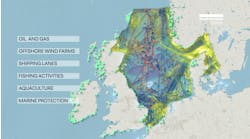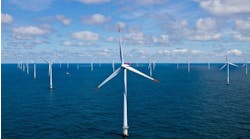Commentary: new baseline needed for marine biodiversity monitoring
Nicole Yeomans * NatureMetrics
Global offshore wind development is growing rapidly. In 2020, global offshore wind capacity was estimated at around 40 GW. By 2050 this capacity is expected to reach 630GW, demonstrating significant global commitments to rapidly move to renewables. This high level of development comes with potential risk to the environment if not responsibly managed. It's therefore important to ensure this progress is being delivered sustainably, setting the offshore renewables industry up for success for the long term.
With growing pressure from across industries and incoming regulatory frameworks such as the Taskforce on Nature-related Financial Disclosures and the Global Biodiversity Framework set out at COP15, companies within the sector must ensure their environmental impact assessments offer comprehensive data to enable effective decision making to protect the environment.
Using insights powered by environmental DNA (eDNA), there are now nature-based solutions to help companies improve their nature-monitoring and reporting. The eDNA process provides a valuable insight into biodiversity health, offering a comprehensive view of the entire tree of life through a simple sampling of water, soil, and sediment. As species move and interact within their environment, they shed waste products containing DNA. By sequencing this DNA, scientists can obtain an accurate picture of the biodiversity within their surveyed location. These insights can then be used to inform important decisions from planning through to implementation and ongoing mitigation.
While the offshore wind sector is increasingly receiving recommendations to integrate eDNA sampling into monitoring activities, the industry lacks clear guidance on effective methodologies to use. To tackle this challenge, NatureMetrics teamed up with consulting firm Natural Power and EDF Renewables to establish a methodology that could not only be evidenced as being useful and powerful for the industry, but could also be recommended for future projects to easily implement eDNA monitoring, allowing companies to collect the most comprehensive data on their project sites.
In 2022, Natural Power obtained grant funding for 50% of the project costs through the Offshore Wind Growth Partnership’s Innovation Grant, and the research was conducted off the Northumberland coastline at EDF Renewables’ Blyth Offshore Demonstrator (BOD), a small coastal wind farm located 0.5 miles off the coast of Blyth, Northumberland, England. This site operates as a leading example of innovation, with the wind farm being the first to use float and submerge gravity-based foundations, an alternative to the traditional methods of drilling or piling foundations into the seabed. EDF Renewables committed to undertaking extensive pre- and post-construction fish and shellfish monitoring surveys. Natural Power led on the design, coordination and implementation of these surveys for over a decade using traditional trawl fishing methods. The main aim of this research was to investigate whether eDNA sampling could provide an effective and replicable methodology as an alternative to the currently accepted standard fish trawling method, an invasive sampling method. Natural Power fish ecologists collected data at 10 stations within the BOD wind farm, using both eDNA and standard fish trawling methods.
Sampling for eDNA involved collecting water samples from roughly one meter above the seabed. This sampling method carries reduced safety risks as compared to traditional methods and does not require the specialist vessels needed for trawling, nor fish ecologists to identify species in the field. This allows eDNA samples to be collected as part of other site investigation works being conducted, reducing the number of vessels required and dependency on the availability of specialised vessel and staff, reducing the risk of delay while also providing a non-destructive sampling method. The eDNA results uncovered a greater diversity of species than captured using traditional methods, giving a fuller picture of the community composition and providing greater understanding of the way in which the fish community utilize the site. When eDNA data were compared with concurrent trawl data there was a significant difference in community composition due to the greater number of species detected by eDNA. However, both seasonal and spatial trends in species composition and community composition were similar between eDNA, concurrent trawl and historical trawl datasets, confirming the robustness of eDNA technology for monitoring biodiversity around offshore wind farms.
Michelle Elliott, Principal Environmental Consultant at Natural Power, said: “When we originally applied for the grant, we were confident this proof of concept study would demonstrate eDNA as an effective method for monitoring fish ecology around offshore wind farms. However, the results have far exceeded expectations, capturing data on elusive and migratory fish species as well as mammal and bird species and even benthic invertebrates from the one sample. Natural Power and NatureMetrics shared their expertise to design the methodology and the method was further developed and improved over the course of the project surveys. The method development and final methodology, alongside the results and analysis will be included in a white paper to be published in the near future.”
Through this research, this innovative method was proved to not only provide adequate data that is currently obtained through traditional methods but also a wealth of new information that can be used to assess the potential impacts or benefits of offshore wind farms on migratory and illusive taxa. For the first time, it has provided information on how fish species utilize the new habitat created by the wind farm structures for feeding and shelter, which until now has been widely hypothesized but not accurately assessed. This is because trawl sampling cannot be conducted in close proximity to the turbines due to health and safety risk, whereas water samples for eDNA analysis can.
As a result of this pioneering research, NatureMetrics, Natural Power and EDF Renewables recommend its methodology for biodiversity monitoring within the industry for three key reasons:
1. The ease of use of eDNA sampling means that environmental risks and opportunities can be identified earlier in the project lifecycle, allowing for efficient management or targeted mitigation. This also means change over time can be more effectively measured, ensuring companies can more closely monitor and report the impact they have on their fauna at their sites and therefore better identify ways to minimize it.
2. eDNA sampling provides greater opportunities for offshore wind farm developments to use a larger pool of vessels which can undertake the survey work and can be combined with other site-based activities. This could greatly reduce the costs, fuel consumption, potential health and safety risks and risks of delays to surveys and therefore to subsequent consents. The technique also allows for the collection of biological data with less potential impacts on the environment than traditional trawls. Crucially, this type of work is not an added challenge to an offshore wind developer, but rather a solution to improving their environmental management that can be integrated into existing environmental assessments with little extra effort.
3. Lastly, eDNA monitoring lifts the veil on marine environments in ways not possible through conventional techniques. Species that are rare or endangered, that have certain behavioral characteristics, or are even just too large or too small can often be missed through other methods, but monitoring techniques using eDNA lead to much more accurate data on marine environments.
Ryanne Burges, Director of Offshore Wind and Ireland at EDF Renewables UK and Ireland explained: “We believe that eDNA techniques have the potential to reduce barriers in consenting for offshore wind farm projects in the future through more targeted baseline data collection, mitigation, and monitoring measures. With approval from regulators, such techniques can become a viable alternative to traditional fish survey techniques in the offshore environment, potentially bringing significant benefits to both the developer and stakeholder communities. We are eager to glean the insights from this valuable research work.”
With the global offshore wind capacity expected to grow 1,475% by 2050, the industry is not slowing down any time soon. But for the clean energy sector to thrive, its development methods must prioritize nature conservation and biodiversity. It's counterproductive to harness clean energy for environmental protection if the construction of its source harms the environment. Therefore, by prioritizing sustainable practices now, we can ensure that the pursuit of renewable energy solutions aligns with the larger goal of environmental preservation for generations to come.
The author
Nicole Yeomans is Marine Business Development Manager and Marine Ecology Expert at NatureMetrics.



